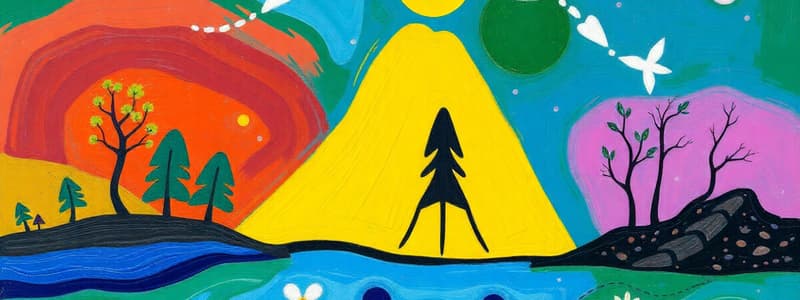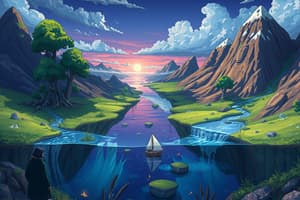Podcast
Questions and Answers
What defines renewable resources?
What defines renewable resources?
- Resources that take millions of years to replenish
- Resources that replenish themselves quickly or are available in near-infinite quantities (correct)
- Resources derived solely from fossilized organic matter
- Resources that are always available in limited quantities
Which of the following is an abiotic resource?
Which of the following is an abiotic resource?
- Fossil fuels
- Animals
- Plants
- Coal (correct)
Which of the following fossil fuels is formed from decomposed plant matter only?
Which of the following fossil fuels is formed from decomposed plant matter only?
- Oil
- Natural gas
- Coal (correct)
- Propane
What is a key characteristic of non-renewable resources?
What is a key characteristic of non-renewable resources?
What practice is NOT considered sustainable agriculture?
What practice is NOT considered sustainable agriculture?
Which natural disaster is characterized as a sudden shaking of the ground?
Which natural disaster is characterized as a sudden shaking of the ground?
Which of the following is a method of preventing the impact of natural disasters?
Which of the following is a method of preventing the impact of natural disasters?
Which of these is a result of burning fossil fuels?
Which of these is a result of burning fossil fuels?
How can crop rotation benefit soil quality?
How can crop rotation benefit soil quality?
What primarily drives the process of runoff in the water cycle?
What primarily drives the process of runoff in the water cycle?
What is the primary process through which plants remove carbon dioxide from the atmosphere?
What is the primary process through which plants remove carbon dioxide from the atmosphere?
Which of the following processes leads to the release of carbon dioxide into the atmosphere?
Which of the following processes leads to the release of carbon dioxide into the atmosphere?
What role do nitrifying bacteria play in the nitrogen cycle?
What role do nitrifying bacteria play in the nitrogen cycle?
Which cycle includes evaporation as one of its main processes?
Which cycle includes evaporation as one of its main processes?
What is the largest reservoir of carbon on Earth?
What is the largest reservoir of carbon on Earth?
How do human activities disrupt the nitrogen cycle?
How do human activities disrupt the nitrogen cycle?
Which process is NOT a part of the water cycle?
Which process is NOT a part of the water cycle?
What happens during condensation in the water cycle?
What happens during condensation in the water cycle?
Which of the following processes directly contributes to the phase change from solid to gas in the water cycle?
Which of the following processes directly contributes to the phase change from solid to gas in the water cycle?
Which process is described as the exchange of gases that releases carbon dioxide back into the atmosphere?
Which process is described as the exchange of gases that releases carbon dioxide back into the atmosphere?
Flashcards
Photosynthesis in the Carbon Cycle
Photosynthesis in the Carbon Cycle
Process where plants convert carbon dioxide from the atmosphere into sugars using sunlight.
Respiration in the Carbon Cycle
Respiration in the Carbon Cycle
Process where organisms break down sugars to release energy, producing carbon dioxide as a byproduct.
Combustion in the Carbon Cycle
Combustion in the Carbon Cycle
Burning of fossil fuels, releasing carbon dioxide into the atmosphere.
Dissolving in Oceans in the Carbon Cycle
Dissolving in Oceans in the Carbon Cycle
Signup and view all the flashcards
Nitrogen Fixation
Nitrogen Fixation
Signup and view all the flashcards
Nitrification
Nitrification
Signup and view all the flashcards
Nitrogen Assimilation
Nitrogen Assimilation
Signup and view all the flashcards
Evaporation in the Water Cycle
Evaporation in the Water Cycle
Signup and view all the flashcards
Condensation in the Water Cycle
Condensation in the Water Cycle
Signup and view all the flashcards
Precipitation in the Water Cycle
Precipitation in the Water Cycle
Signup and view all the flashcards
Runoff
Runoff
Signup and view all the flashcards
Natural Resources
Natural Resources
Signup and view all the flashcards
Renewable Resources
Renewable Resources
Signup and view all the flashcards
Nonrenewable Resources
Nonrenewable Resources
Signup and view all the flashcards
Biotic Resources
Biotic Resources
Signup and view all the flashcards
Abiotic Resources
Abiotic Resources
Signup and view all the flashcards
Fossil Fuels
Fossil Fuels
Signup and view all the flashcards
Crop Rotation
Crop Rotation
Signup and view all the flashcards
Selective Logging
Selective Logging
Signup and view all the flashcards
Environmental Sustainability
Environmental Sustainability
Signup and view all the flashcards
Study Notes
Carbon Cycle
- Carbon cycles through Earth, atmosphere, and living things.
- Key processes in the carbon cycle:
- Photosynthesis: Plants absorb CO2 from the atmosphere, making glucose.
- Respiration: Living things release CO2 into the atmosphere.
- Combustion: Burning fossil fuels releases CO2.
- Ocean absorption: CO2 dissolves in oceans as carbonic acid.
- Humans add excess CO2, impacting global warming and climate change.
Nitrogen Cycle
- Nitrogen cycles between the atmosphere, Earth, and living things.
- Nitrogen Fixation: Lightning or soil bacteria convert atmospheric nitrogen to ammonia.
- Nitrification: Bacteria convert ammonia to nitrates and nitrites.
- Plants (like legumes) absorb these forms of nitrogen.
- Humans disrupt the cycle through excessive nitrogen addition (eutrophication).
Water Cycle
- Circulates freshwater on Earth's surface, in the air, and underground.
- Key processes:
- Evaporation: Liquid water turns to water vapor.
- Condensation: Water vapor turns into liquid or solid water.
- Precipitation: Water falls as rain, snow, hail, or sleet.
- Sublimation: Solid ice turns directly into water vapor.
- Transpiration: Water vapor released by plants.
- Runoff: Water flowing over land.
- Infiltration: Water soaking into the ground.
- The cycle sustains life, weather, and ecosystems.
Natural Resources
- Naturally occurring materials useful to humans.
- Classified as:
- Renewable (e.g., air, water, sunlight, plants): Replenish quickly.
- Non-renewable (e.g., fossil fuels): Limited or slow to replenish.
- Biotic (e.g., plants, animals): Living or once-living.
- Abiotic (e.g., minerals, rocks): Non-living.
- Air, water, soil, iron, and forests are crucial.
Renewable and Non-Renewable Energy
- Both types power electricity generation and other uses.
- Renewable sources: Wind, water, geothermal, biomass, and plants.
- Hydroelectric power is renewable since water is reused.
- Non-renewable sources (fossil fuels): Coal, oil, and natural gas.
- Formed from ancient organic matter.
- High energy, cheap, and abundant.
- Release CO2 when burned, harming the environment and contributing to climate change.
Fossil Fuels
- Formed from ancient organic matter (plant/animal remains).
- Types: Coal, oil (crude oil), natural gas.
- Burning releases high amounts of energy.
- Advantages: High energy, affordable, plentiful, readily available.
- Disadvantages: Non-renewable, air and water pollution, greenhouse gas emissions.
Environmental Sustainability
- Management of resources to ensure they stay available for future use.
- Renewable resources replenish faster than they're used.
- Non-renewable resources are finite.
- Sustainable development: Combines environmental protection with economic growth.
- Practices to support sustainability: Crop rotation, selective logging.
Natural Events
- Natural events (e.g., floods, volcanoes, earthquakes) can cause damage and threaten life.
- Often interrelated.
- Driven by energy from the sun or Earth's interior.
- Some are predictable, others are difficult to foresee.
- Impacts can range from beneficial (e.g., fertile soil) to harmful (e.g., widespread destruction).
- Secondary events, like fires or power outages, can worsen the effects on humans and wildlife.
Natural Disasters
- Examples: Hurricanes, earthquakes, tornadoes, mudslides, volcanoes, tsunamis.
- Preparation methods to mitigate damage:
- Warning systems
- Evacuation plans
- Community preparedness plans
- Road improvements
- Preventative measures to reduce the risk:
- Identifying flood plains
- Constructing dams, levees, gates
- Afforestation (planting trees)
Studying That Suits You
Use AI to generate personalized quizzes and flashcards to suit your learning preferences.





